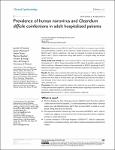Prevalence of human norovirus and Clostridium difficile coinfections in adult hospitalized patients
Stokely, Janelle N.
Niendorf, Sandra
Taube, Stefan
Höhne, Marina
Young, Vincent B.
Rogers, Mary A. M.
Wobus, Christiane E.
Objective: Human norovirus (HuNoV) and Clostridium difficile are common causes of infectious gastroenteritis in adults in the US. However, limited information is available regarding HuNoV and C. difficile coinfections. Our study was designed to evaluate the prevalence of HuNoV and C. difficile coinfections among adult patients in a hospital setting and disease symptomatology. Study design and setting: For a cross-sectional analysis, 384 fecal samples were tested for the presence of C. difficile toxins from patients (n=290), whom the provider suspected of C. difficile infections. Subsequent testing was then performed for HuNoV genogroups I and II. Multinomial logistic regression was performed to determine symptoms more frequently associated with coinfections. Results: The final cohort consisted of the following outcome groups: C. difficile (n=196), C. difficile + HuNoV coinfection (n=40), HuNoV only (n=12), and neither (n=136). Coinfected patients were more likely to develop nausea, gas, and abdominal pain and were more likely to seek treatment in the winter season compared with individuals not infected or infected with either pathogen alone. Conclusion: Our study revealed that patients with coinfection are more likely to experience certain gastrointestinal symptoms, in particular abdominal pain, suggesting an increased severity of disease symptomatology in coinfected patients.
No license information

